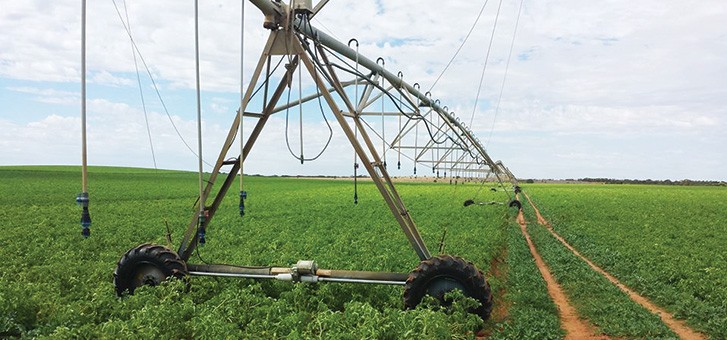Record levels of government funding are providing local growers along South Australia’s River Murray with the opportunity to remain at the forefront of irrigation practice, while returning much needed water to the MurrayDarling Basin (MDB) River system.
The $265million Federal Governmentfunded South Australian River Murray Sustainability (SARMS) program has been designed to achieve the industry driven outcomes first sought by the Water Industry Alliance through the original River Murray Improvement Program – and is now being delivered on behalf of the Government of South Australia by Primary Industries and Regions SA (PIRSA).
The commitment
In August 2013, a National Partnership Agreement between the South Australian and Australian governments was signed which allocated a total of $265million to SARMS, with the commitment to return 40GL in South Australian River Murray water entitlements to the Murray Darling River system over a six-year period.
In less than three years, 33GL is now ready for return into the river system. Funding opportunities for local irrigators are being awarded under the $240million SARMS Irrigation Industry Improvement Program (3IP), and $25million for regional development is being provided via the SARMS Regional Economic Development (RED) program.
On the provision that entitlements of water are returned to the River Murray, 3IP funding is giving local growers the ability to adopt innovative systems to improve their water and production efficiencies.
There’s added spinoffs for the region as well. Independent analysis of the program showed that for every dollar of 3IP investment, it will stimulate about four times this in economic activity across the region – resulting in about $1billion of economic activity from the total investment by the Australian Government.
According to Andy Roberts, CEO of the Water Industry Alliance, “When organising the 3IP program, the key principle was to support irrigators that were going to stay in the industry; those that were going to be a part of the future of the irrigation industry and the future of the region.
“The requirement to give back water was something that needed to be done for the MDB plan, but it was seen as an opportunity rather than a risk. We explored ways to encourage irrigators to operate as businesses, rather than just as irrigators, and to explore what they could do to maximise their businesses and maximise what they could do for the state,” said Mr Roberts.
Funding innovation
3IP is designed to deliver maximum and lasting benefit from the funding dollar to river communities through a competitive application process.
This is being achieved by encouraging SA River Murray water access entitlement holders to optimise their irrigation practices.
The $240 million in 3IP funding is allocated through three investment streams:
- Stream One – Irrigation Efficiency – supporting water efficiency improvements. All projects under stream one are required to return at least 50 per cent of the proposed water savings, with a minimum of 10ML of technically feasible water savings to be provided under 3IP.
- Stream Two – Water Returns – to acquire water through direct purchase.
- Stream Three – Irrigation Industry Assistance – accessible to improve farm productivity only when the applicant is returning water through streams one and/or two.
The remaining $25million has been used to support an RED program to deliver significant outcomes in regional research and economic development through:
- $12.5 million Regional Development and Innovation Fund
- $5 million Industryled Research SubProgram
- $7.5 million redevelopment of the Loxton Research Centre.
The following two case studies are from major contributors to the South Australian agricultural industry. Each has successfully implemented 3IP funding to develop their irrigation infrastructure, and both are already reaping the rewards of more efficient and practical systems.

The control room for the Jubilee Almonds irrigation system. It is set that high so the base is above the 1956 flood level.
Securing water supply
Jubilee Almonds, located at Overland Corner near Waikerie, SA, recently completed major pump and irrigation system upgrades across their orchards after receiving $5.6million of funding from streams one, two and three of the 3IP program.
Canopy lowthrow sprinklers were upgraded to a dual microsprinkler/drip system during replanting, and according to Jubilee Almonds CEO Brendan Sidhu, the benefits of the upgrade have been nothing short of impressive.
“As the ground at the orchard is very sandy and conducive to drift, initially our plantings were irrigated via lowthrow sprinklers. With the advancement of drip, we decided to replace the low throws with a dual drip and micro sprinkler system.
“By introducing a dual system of both microsprinkler and dripper, the benefit is twofold. The microsprinklers enable us to establish cover crop to hold the soil between each tree, as well as helping to control frost during winter. With cover crop in place, the drip system is then able to be used to irrigate the trees as well as distribute fertiliser.”
According to Mr Sidhu, the orchard’s original system did not provide the orchard with a high level of water security.
“We originally had two 500kW electric pumps down at the river and a diesel booster pump installed at the orchard to boost water flow and pressure. Each of the pumps had to be started manually, and if one of the pumps failed, we would lose 50 per cent of our pumping capacity. If there was a power outage, we simply had no backup to keep the pumps running.
“The new system now involves four 280kW turbine pumps, meaning we would only lose 25 per cent of capacity if one was to fail.
They are now also controlled by variable speed drives, giving us the capacity to run them at anywhere between 40L per second to up to 650L per second.
“The new system has enabled us to eliminate the diesel pump altogether and has provided us with a fantastic level of flexibility for different demands of water across the orchard.
“Overall, we have been able to increase efficiencies and we now have a system that is a lot more reliable,” said Mr Sidhu.
Sprouting new opportunities
Byrne Brothers operates a dynamic trio of vineyards, incorporating an impressive acreage of wetlands and agricultural farmland dotted across the SA MurrayDarling Basin region.
Major irrigation infrastructure upgrades were recently carried out at the Byrne Lone Oak Farm, which neighbours the company’s Glen Devlin Vineyard at Devlins Pound near Waikerie.
These upgrades were initiated to allow for the production of new and diverse crops such as 800 hectares of lucerne.
According to Rob Byrne, a partner in the Byrne Brothers family business, contracts to receive the 3IP funding were signed in 2014 with pump infrastructure undergoing installation in mid2015.
“There were a number of different upgrades completed across the Lone Oak property. These included the installation of diversion pumps from the River Murray, installation of an upgraded rising main as well as a relift booster pump station and associated distribution mains with connections for centre irrigation pivots.”
According to Mr Byrne, the upgrades have resulted in large water efficiencies, increase in pumping capacity and an increase in production of other crop via shared farming agreements.
“Our system is innovative in itself, with its design allowing for it to be moved from a circle to another circle area within two hours. This means we can irrigate up to three circles of lucerne or other crops with one centre pivot.”
According to Mr Byrne, the upgrades have reached further than the farm and have provided tangible benefits for the community at large.
“With the support of SARMS 3IP program, we have been able to employ more people and improve their skill base by adopting new technologies.
“The funding has given us the freedom to be highly innovative in designing systems, and working with suppliers has led to greater conversations and activation of irrigation best practices.
“Although 3IP is a government recovery of water entitlements, the program seeks out best practice to bring sustainable agriculture to farming communities that improve crops and output,” said Mr Byrne.
The benefits of 3IP so far
According to Ben Fee, PIRSA Agribusiness Manager, the benefits of 3IP funding are widespread and have already resulted in impressive innovation measures and significant water returns.
“SARMS 3IP has provided the opportunity for longterm water delivery infrastructure changes that deliver ongoing benefits to multiple end users, based along the River Murray,” said Mr Fee.
“Just one example is the energy savings generated through the installation of the latest industry leading pump technologies within the SARMS 3IP funded irrigation projects, which will provide productivity benefits to around 200 irrigators.
“Many of the funded projects have also factored in future technology advancements in the area of solar power, which they are now able to easily introduce without further significant capital expenditure as a result of their SARMS 3IP project.
“The program is unique in that the water returns look after the environment, the irrigation and production efficiencies look after the farmers, and the mix of regional development opportunities look after the region’s communities.
“The SARMS National Partnership Agreement seeks the final water returns to be made by March 2017, with the program well on target to meet this goal,” said Mr Fee.
The Murray-Darling Basin
Covering 14 per cent of the total landmass of Australia, the MurrayDarling Basin (MDB) is Australia’s main source of food production and agricultural farmland. Known as Australia’s ‘food bowl’, the MDB generates 39 per cent of the national income derived from agricultural production.
The MDB is defined by its water, involving 23 rivers and their catchments, yet less than 15 per cent of the area of the basin contributes to runoff – except in times of flood.
High evaporation rates, expansive floodplains and significant water diversions for towns and agriculture mean that much of the surface water in the basin does not reach the ocean.
As three quarters of Australia’s irrigated crops and pastures are grown within the basin, numerous programs have been put in place by government and authorities to help secure the future of Australia’s most precious water system.
The mighty river murray
The River Murray is the lifeblood of the Murraylands and Riverland regions of South Australia. With the area home to 70,000 South Australians and $840 million worth of irrigated agriculture, the River Murray supports industries such as vegetables, grains and livestock in the Murraylands, and irrigated horticulture (fruit, nuts and grapes) in the Riverland.
Water returns will aid in keeping the Murray Mouth open and flush salt from the system, while meeting salinity and water quality targets to protect the Coorong, Lower Lakes and the river channel, and provide environmental flows to River Murray wetlands and floodplains.



















